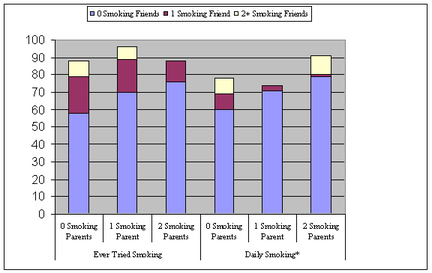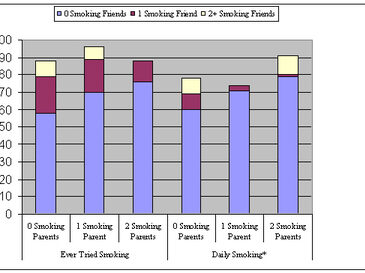There are a variety of relationships and experiences that might influence a person’s decision to smoke. In the last issue of ASHES 2(6), we reviewed a study that examined the influence of parental smoking on the smoking habits of 12th graders. However, it is important to acknowledge that parents are not the only source of pressure and influence in an adolescent’s life. This week we review an article by Bricker, Peterson, Anderson, Rajan, Leroux, and Sarason (2006), which compares the influence of parental smoking and peers/friends smoking on adolescents’ decision to try smoking, and smoking regularly.
Participants for this study were selected from the 7,046 students enrolled in the Hutchinson Smoking Prevention Project (HSPP). Eligible participants reported whether parents and close friends smoked; 4,744 teens (49% female, 91% Caucasian), of those eligible in both control and intervention cohorts of the HSPP, participated in this study. Parents completed mail surveys when their children were in 3rd grade. Participants provided information about friends’ smoking during the 5th grade, and provided information about their own smoking behavior (i.e., age at which the participant reported first smoking a cigarette, first smoking monthly, and first smoking daily) during the 12th grade. Children completed surveys while in class. Saliva samples confirmed recent cigarette smoking.
In the 12th grade, 66% of participants had at least tried smoking and 56% reported smoking monthly: 69% of those who reported smoking monthly also reported smoking daily. Of the participants with no smoking parents, 58% of those with no smoking friends tried smoking, 79% of participants with one smoking friend tried smoking, and 88% of participants with two or more smoking friends tried smoking. Figure 1 illustrates these results. Of the participants with one smoking parent, 70% of those with no smoking friends tried smoking, 89% of participants with one smoking friend tried smoking, and 96% of participants with two or more smoking friends tried smoking. Of the participants with two smoking parents, 76% of those with no smoking friends tried smoking, 88% of participants with one smoking friend tried smoking and 87% of participants with two or more smoking friends tried smoking.
Of the participants with non-smoking parents who tried smoking and reported smoking monthly, 60% of those with non-smoking friends reported smoking daily, 69% of those with one smoking friend reported smoking daily, and 78% of those with two or more smoking friends reported smoking daily. Of the participants with one smoking parent who tried smoking and reported smoking monthly, 71% of participants with non-smoking friends reported smoking daily, 74% of participants with one smoking friend reported smoking daily, and 72% of participants with two or more smoking friends reported smoking daily. Of the participants with two smoking parents who tried smoking and reported smoking monthly, 79% of those with non-smoking friends reported smoking daily, 80% of participants with one smoking friend reported smoking daily, and 91% of participants with two or more smoking friends reported smoking daily.

FIGURE . PERCENT OF PARTICIPANTS WHO EVER TRIED SMOKING AND SMOKE REGULARLY, BY NUMBER OF PARENTS AND FRIENDS WHO SMOKE (ADAPTED FROM BRICKER ET AL., 2006). Click image to enlarge.
* Please note that the ‘Smoking Regularly’ group is a subset of the ‘Ever Tried Smoking’ group.
These findings suggest that having smoking friends contributes more to a child’s decision to try smoking than do non-smoking parents. Further, there seems to be a direct relationship between number of smoking friends and the participants’ decision to try smoking among participants with non-smoking parents. However, the number of smoking friends does not seem to be as important among participants with smoking parents, except among participants with two smoking parents and two or more smoking friends; this irregularity might be the result of the small sample size for this group.
There are several limitations to the study. The participants are mostly Caucasian (91%), and are from a very similar socio-economic background. Also, researchers did not evaluate the impact of other covariates on smoking, such as socio-economic status and education. Nonetheless, this study brings demonstrates important factors that can influence an adolescent’s decision to try smoking and possibly continue smoking.
Among adolescents with non-smoking parents, the influence of smoking friends and peers increase the chances that the adolescent will try smoking. However, smoking parents have greater influence regarding participants’ long-term smoking habits. Though adolescents with smoking friends might feel pressure from peers to try cigarettes, behavior at home remains the strongest predictor for long-term behavior and lifestyle/health choices. Public health workers should consider this finding when creating treatment and prevention programs for youth and their families.
–Siri Odegaard.
REFERENCES
Bricker, J. B., Peterson, A. V., Anderson, M. R., Rajan, K. B., Leroux, B. G., & Sarason, I. G. (2006). Childhood friends who smoke: Do they influence adolescents to make smoking transitions? Addictive Behaviors, 31(5), 889-900.
What do you think? Please use the comment link below to provide feedback on this article.




